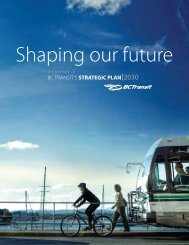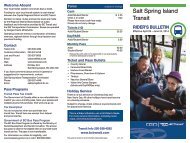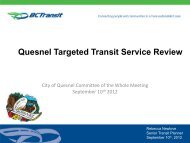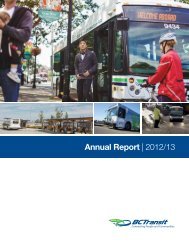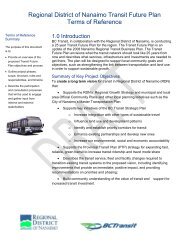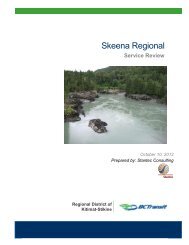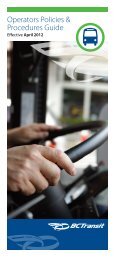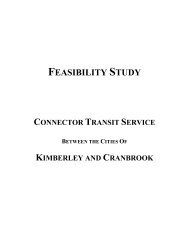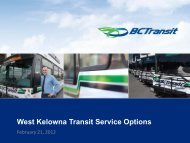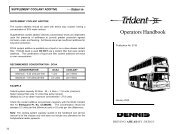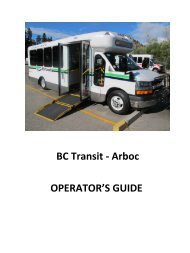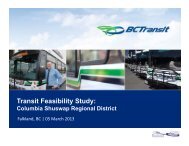Appendix A4 - GlossaryGlossaryAccessible buses – Accessible buses are ableto accommodate riders who have wheelchairs orscooters. Accessible bus stops are clearly markedwith the international wheelchair symbol, androutes that are fully accessible are indicated in theRider’s Guides.Biodiesel – Biodiesel is a combination of a cleanburning non-toxic biodegradable alternative fuelcombined, at any percentage, with diesel to beused in diesel engines. The biofuel componentis produced from renewable sources such asvegetable oil and animal fats. Minimum biodieselcontent in fuels will be regulated by governmentsin the future.Canadian Urban <strong>Transit</strong> Association – CUTAis the association for providers of urban transitservices and the voice of the public transitindustry in Canada.Capital Costs – The sum of money paid forfacilities and equipment (including taxes andinterest charges) with a service life exceedingone year.Community Bus – Using minibuses on fixedroutes used to efficiently serve lower density/suburban markets and feed the mainline busnetworks.Componentization – Componentization iswhere an asset is broken down into its majorcomponents that have significantly differentuseful lives.Conventional transit – Serves the generalpopulation in urban settings using mid-sized,large or double-deck buses. The buses areaccessible and low-floor and run on fixed routesand fixed schedules.Custom transit – Employs vans andminibuses and taxis for dial-a-ride anddoor-to-door handyDART service for passengerswith disabilities who cannot use conventionaltransit. Contracted Taxi Supplement and TaxiSaver (discounted coupon) progams make for aflexible service that adapts to customer needs.Cost-sharing agreement – An agreementbetween <strong>BC</strong> <strong>Transit</strong> and the municipality for theprovision of transit service or the development ofa transit study.Double-deck bus – <strong>BC</strong> <strong>Transit</strong>’s low-floordouble-deck buses are 12 metres (40 feet) long,2.5 metres (eight feet) wide, and 4.3 metres (14feet) tall and can carry 110 passengers. Comparedto a single deck, 12-metre bus, the double-deckbus provides a 120 per cent increase in carryingcapacity at a capital cost that is only40 per cent higher.Effectiveness – A measure of the ability of thetransit system to carry out the required services.Feasibility study – A two-phase study,performed by <strong>BC</strong> <strong>Transit</strong>, consisting of a <strong>Transit</strong>Concept Plan and a <strong>Transit</strong> Service Plan underthe terms of a cost-sharing agreement between<strong>BC</strong> <strong>Transit</strong> and the municipality.handyDART – Custom door-to-door service forthose passengers who cannot use conventionaltransit due to a disability. Riders must beregistered with the handyDART office before theycan use the service. Also known as custom transit,handyDART stands for handy Dial-a-Ride-<strong>Transit</strong>.Hybrid vehicle – A vehicle that uses two ormore distinct power or fuel sources. The termmost commonly refers to a hybrid electric vehiclewhich combines an internal combustion engineand an electric motor powered by batteries.Hydrogen fuel cell – An electrochemicalenergy conversion device that uses hydrogengas to produce electricity, water and heat. Itoperates much like a battery but does not requirerecharging. If sufficient hydrogen fuel is availableit can generate electricity almost indefinitely.Low-floor bus – Designed for easy boardingso the entire floor is close to the pavement withno entry steps. For passengers who use walkers,crutches or who have difficulty stepping up,all low-floor buses have a kneeling feature thatlowers the entry level even further and provides aramp for wheelchair and scooter access.Mode – A form of travel, e.g., transit, pedestrian,bicycle, automobile, or mixed mode such asbicycle and transit.Municipality – For the purpose of agreementsunder the British Columbia <strong>Transit</strong> Act,municipalities are defined as cities, townships,villages, or regional districts, or a combinationof these, involved in the operation, funding orfeasibility assessment of a transit system.Operating cost – The sum of all costsassociated with the operation, maintenanceand administration of the transit system duringa specified period excluding depreciation andinterest paid on loans for capital outlays.Operating cost recovery – Reflects annualoperating revenue divided by total operatingcost. This ratio indicates the proportion of costsrecovered from operating revenue. Fares areestablished by the local partners. A strong costrecovery is desirable, as it reduces the subsidyfrom the taxpayer. This factor, however, is amunicipal policy decision.Operating cost per service hour – Reflectsannual operating cost divided by annual totalservice hours. The ratio also reflects efficiency.Increasing cost per hour indicates operating costsare increasing faster than service hours.Operating cost per revenue passenger–Reflects annual operating cost divided by annualpassengers carried. This ratio indicates theefficiency of transit expenditures directed towardpassengers carried. Consistent or decreasing costper passenger indicates that ridership is growingfaster than costs.Operating company – The company selectedby <strong>BC</strong> <strong>Transit</strong> and the municipality to operate thetransit system under the terms of the<strong>Transit</strong> Service Agreement and the AnnualOperating Agreement.Operating expenses – The sum of all costsassociated with the operation, administrationand maintenance of the transit system duringa specified period, excluding depreciation andinterest paid on loans for capital outlays.60<strong>BC</strong> TRANSIT <strong>2008</strong>/<strong>09</strong> <strong>ANNUAL</strong> <strong>REPORT</strong>
Paratransit – Serves small town and rural B.C.as well as some suburban areas using minibuses,taxis and vans for a flexible routing andschedules.Passengers per service hour – Reflect annualpassengers divided by annual total servicehours. This ratio is a primary measure of theeffectiveness of the service provided. The ratioimproves with lower average trip lengths, orhigher average speeds.Per capita – estimates use populationfiguresfrom the most recently published census,adjusted annually by B.C. Statistics andcollated for the respective <strong>Transit</strong> Service Areaby <strong>BC</strong> <strong>Transit</strong>.Performance measures – Are statistical ratioscombining system outputs, and transit servicearea statistics to benchmark performance withinthe industry and operational trends over time.Paratransit – Bus or van service in towns andrural areas where the population density doesnot warrant conventional bus service. Moreflexible than conventional fixed route transit,paratransit typically offers both custom doorto-doorand fixed route service, with a flexibletimetable to accommodate route deviation.Peak period (or Hours) – That period of timeduring a typical weekday in which the maximumamount of travel occurs. Usually a morning andevening peak are observed as a result of workand school related trips. The opposite of peakperiod is base or off peak period.Rapid transit – High quality rail and bustransportation that meets service demandbetween regional and local town centres andserves future population growth, land usedevelopment, economic development, andemployment trends.Revenue passengers – Represent transit riderswho have made one fare payment to use thetransit service. (Passengers who use a transferand board more than one bus to complete a tripare only counted once).Rides per capita – Reflect annual passengerscarried divided by regional population. This isa measure of market share and effectiveness inservices that transit markets.Service hours – Represent the total numberof hours that the transit fleet is in regularpassenger service.SMARTTooL – A web-based tool to estimateand track Government’s greenhouse gasemissions from its operations. SMARTTool hasbeen developed to ensure that estimates ofgreenhouse gas emissions are credible, exhibitcontinuous improvement, and are consistentwith the Carbon Neutral Government Regulation.Statistics – Include operational outputs andtransit service area statistics. These factors, whenused in a ratio indicate commonly comparedindustry standard performance measures.Taxi saver program – “Taxi Saver” is the nameof a discounted coupon program which providesregistered handyDART clients with up to $80of taxi coupons at half price, valid for use inlocal taxi services. <strong>BC</strong> <strong>Transit</strong> has establishedagreements with local taxi firms in more than adozen communities.Tier 1 – A conventional transit system whoseservice area population is over 50,000.Total revenue – Includes passenger andadvertising revenue. It excludes property tax andfuel tax revenue.ULSD – Ultra Low Sulphur Diesel – describesthe current standard for refining diesel fuelwith substantially lowered sulphur content. Asof October 2006, the ULSD standard is 15 partsper million, much lower than the previous LSDstandard of 500 ppm. This standard dramaticallyreduces emissions of sulphur compounds as wellas reducing oxides of nitrogen, and particulates.U-PASS – universal bus pass for post-secondaryinstitutions where all students pay a fee for abus pass.61<strong>BC</strong> TRANSIT <strong>2008</strong>/<strong>09</strong> <strong>ANNUAL</strong> <strong>REPORT</strong>



